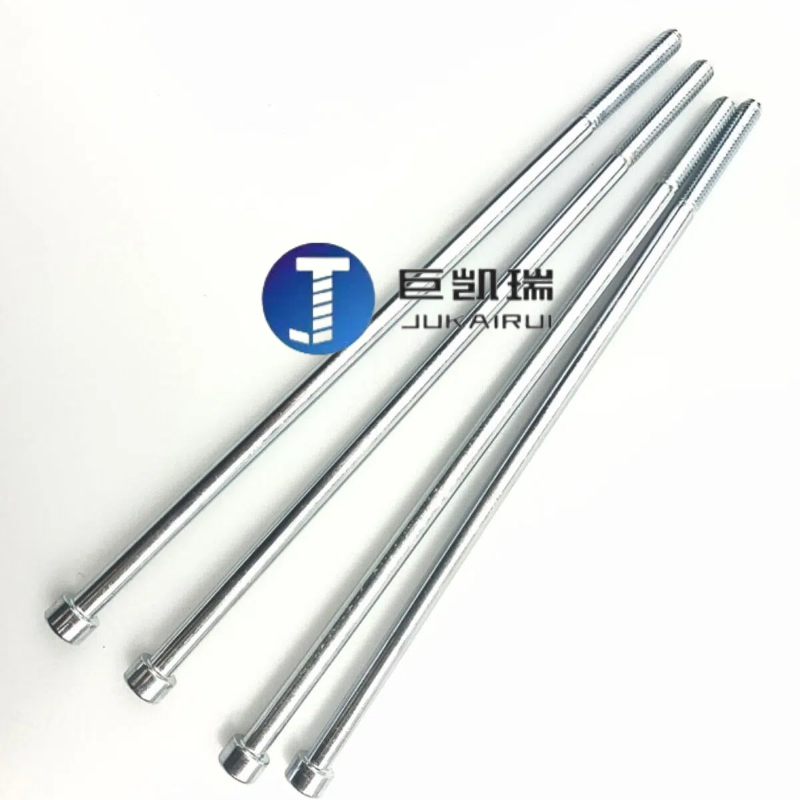Release time:2020-01-16 18:44 Browse:

First, the analysis of whether the extension screw can be reused
Thread condition
If the extension screw is used for the first time, there is no obvious damage to the thread part, such as deformation, wear, fracture, etc., from the perspective of thread integrity, it is possible to be reused. For example, in some indoor furniture assembly, if the lengthening screws used are only normally screwed into and out of wood and other materials once, and the operation is standardized, the threads remain clear and regular, then it is generally still better with the nut or screw hole when used again.
However, if the screw is subjected to a large torque force in the initial use process, resulting in a deformation of the thread, such as being distorted, some threads are flattened, etc., then it may not be able to smoothly screw into the screw hole when used again, or even if it is barely screwed in, it is difficult to provide reliable fastening force, in this case it is not suitable for repeated use.
Head condition
If the screw head (such as crosshead, hexagonal, etc.) is not damaged after the initial use, such as the cross groove is not twisted, the hexagonal head is not angular wear, etc., then it can be normally used with tools such as screwdrivers or wrenches in subsequent use, which is conducive to its repeated use. Taking the extension screws of some fixed parts in the engine compartment of the automobile as an example, if the appropriate tools are used and the operation is proper during the initial disassembly, the head is not damaged, and it can be tightened normally when installed again.
However, if the screw head is obviously damaged in the first use due to improper tool selection (such as using a small screwdriver to screw the crosshead screw, which is easy to cause damage to the cross slot) or excessive force, then it can not be accurately applied torque to tighten the operation when used again, and it should not be reused.
Material characteristics
Different materials of lengthening screws have different possibilities of reuse. For example, ordinary carbon steel extension screws, if used in a more moderate use environment (such as indoor room temperature and pressure environment for fixing some light objects), even if there is a certain microstructure change after the initial use, its overall performance may still meet the requirements of re-use.
For some high-strength alloy steel lengthening screws, in some occasions with extremely high fastening performance requirements (such as aerospace equipment, high-end precision machinery and other fields), even if the thread and head do not look significantly damaged, considering that the stress concentration may have been generated at the microscopic level when it is used for the first time, it is usually not recommended to reuse. To ensure the absolute safety of key parts.
Second, the safety analysis of repeated use of screws
Insufficient fastening force risk
When the screw is used repeatedly, even if the thread and head appear normal in appearance, the previous use may have caused changes in the internal microstructure of the screw, such as small deformation or stress relaxation. This will make it impossible for the screw to achieve the tightening force effect when it is first used. Taking the extension screws used to fix scaffolding in the construction industry as an example, if they are reused and the fastening force is insufficient, when the scaffolding bears the load such as the weight of personnel and construction materials, the screws may become loose, resulting in serious safety accidents such as scaffold collapse.
Fatigue fracture risk
The screw has been subjected to a certain stress cycle during its initial use, and if it is used again, especially in a similar stress environment, the risk of fatigue fracture will be significantly increased. For example, the extension screw used to fix the moving parts on the industrial production line, if it is reused after the first use, with the continuous operation of the equipment, the periodic stress of the screw may make it suddenly fatigue fracture at some point, resulting in the loss of the moving parts, resulting in production line stagnation and even injury.
Corrosion impacts increase risk
If there are slight corrosion marks on the surface of the screw after the first use (possibly due to certain humidity, chemicals and other factors in the environment), then these corrosion parts may be further developed when repeated use. Because in the process of repeated use, the friction and coordination between the screw and the nut or the screw hole will make the corrosion part more vulnerable to damage, thus weakening the overall strength of the screw. For example, if a lengthening screw used once in the Marine environment is used again to fix similar Marine equipment, its corrosion may cause the screw to fail in advance, endangering the safety of equipment and personnel.
Third, the restrictions on the reuse of screws
Application scenario restriction
In the general civilian scenes with low fastening requirements, such as simple furniture assembly in the home room, some non-load-bearing decorative parts fixed, etc., if the condition of the screw (thread, head, etc.) is good, you can consider reuse. However, for key scenes involving life safety and major property safety, such as building structure fixing, bridge engineering, aerospace equipment, high-speed train key parts fixing, etc., regardless of whether the screw appearance is intact, it is generally not recommended to reuse to ensure that nothing is wrong.
Stress condition limitation
If the screw is subjected to relatively small forces at the time of initial use and the force mode is relatively simple (such as simple axial tension or pressure), and the force situation is expected to be similar when repeated use, then the possibility of reuse is relatively large on the premise that it is in good condition. However, if the screw is subjected to complex multi-directional forces (such as axial forces, shear forces, bending moments, etc.) when used for the first time, then even if the appearance is intact, it needs to be extremely cautious when used again, because its internal structure may have been affected by more complex forces, and problems may occur when it is subjected to similar or different forces again.
Environmental restriction
Screws that have been used in a dry, clean, and relatively stable indoor environment with temperature and humidity have relatively small restrictions on reuse if their appearance and performance are not significantly affected. However, if the screw is used under harsh environmental conditions, such as high temperature, high humidity, strong corrosion (such as chemical environment, Marine environment, etc.) environment, even if the appearance seems normal, the internal material performance may have changed greatly, and it is generally not recommended to reuse in order to prevent subsequent safety problems.
To sum up, whether the lengthening screw can be reused requires comprehensive consideration of its own conditions such as threads, heads, application scenarios, stress conditions, environmental conditions and other factors, and in many key areas to ensure safety, it is generally not recommended to reuse screws.
# Lengthening screws # Lengthening bolts # Lengthening outer hex screws # Lengthening inner hex screws # fasteners

